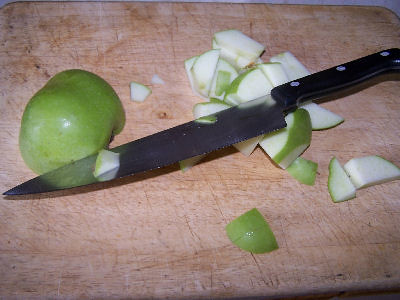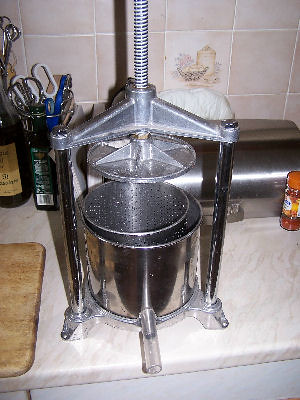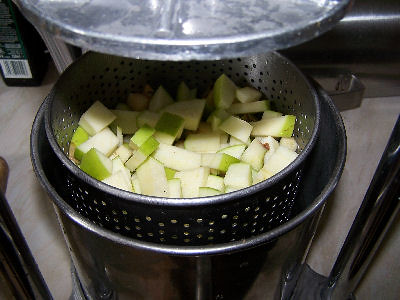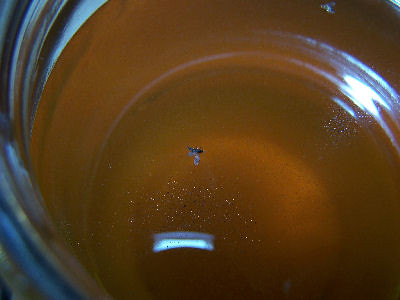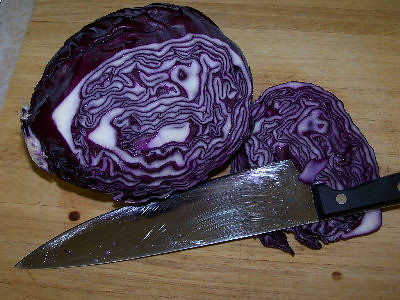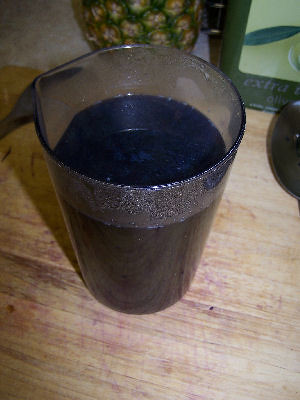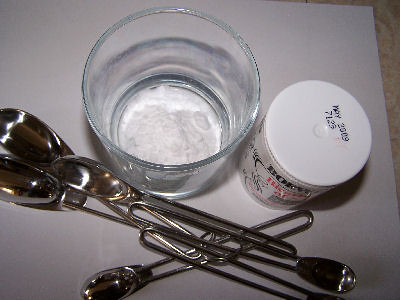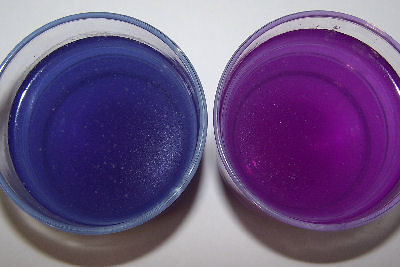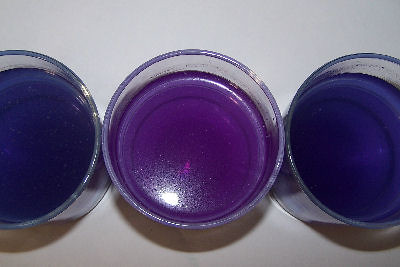My quest here was to produce high quality vinegar that was “re-producible” from only the things I could find in my garden and a few items of basic household materials.
My fist step was to make something to produce some vinegar from. We all know that vinegar is known as “white wine vinegar”, “cider vinegar” etc. This is because the best vinegars are produce from fermented material.
Now I do happen to grow my own grapes, but that felt like cheating, so I gathered my windfall apples and chopped them finely.
Next I sort of cheated – since I have access to a fruit press that looks like this
Had I not had one though, I would have rigged a press using a car jack, frame and tray – or even squeezed juice using over ripe apples and a potato masher and then sieved out the pulp.
However I have a fruit press so I load in the chopped apple and squeezed out the juice
The juice was put into several 3 pint preserving jars. It quickly separates into juice, pulp and “froth”.
I skimmed off the “froth” and covered with a loose cloth. This is because, due to the naturally present yeast, the apple juice will ferment. If I sealed the lid, the pressure would build and ultimately explode. A loose cloth allows the CO2 produced during fermentation to escape but keeps any nasties out.
Within a couple of days a new froth builds up from the fermenting yeast
Once the fermentation has finished, I removed the cloth cover and left the open jar in front of an open window for a couple of days. You do this outdoors but try to prevent spills and rubbish falling in the jar.
Within one day I had success – the fly I hate the most – the tiny vinegar fly had fallen in my cider
Why do I hate it? It’s the reason I need to be super careful when brewing – have a look at the cider one day later
The “film” you can see spreading from the fly is aceto bacteria. This bacteria turns the alcohol (or fruit juice) into vinegar. The jar now contains “mother of vinegar”. This is rather like “sourdough starter”. A small amount introduced into another jar of wine, cider or fruit juice will “infect” the liquid and cause it to turn to vinegar.
There are a couple of “buts” in this process however. The aceto bacteria needs air. Do not cover it (other than with a breathable cloth). When introducing it into a new jar, lift a little of the “scum” with a spoon and “float it” onto the surface. Mixing it will deprive it of air and kill it. Lastly, the “mother” needs food to live. You can “feed it” by running some fresh cider down the side of the jar into the mother once a month. Down the side so as not to “swamp” the bacteria floating on the surface.

So, once we have used out fruit juice to transform a few jars or buckets of cider into good cider vinegar, can we use it? Well not really. Shop bought vinegar is about 5% acid. Home made can be 10% or even more. This is unpalatable to say the least. So it should be diluted. I generally first run it through a coffee filter to remove the bacterial “sludge”, although a siphon tube works and indeed it can be left – its not harmful. However the question remains – how much to dilute it to maintain a good taste and efficacy. One can work from taste but there is a scientific method. We will use a form of titration to measure the relative acidity.
First we need a red cabbage! Roughly chop half a cabbage and boil in a couple of cups of water until the water turns deep purple
Strain the water off through a colander to create a jug of dark purple “cabbage water”
Take two tablespoons of cabbage water and stir them into a glass of water
Next dissolve two tablespoons of bicarbonate of soda in a glass of water (if you didn’t have any bicarb, a lye solution would work)
Next find some “known strength” vinegar. This can be a commercial vinegar or an old batch of yours whose strength is right. Using a pipette / eye dropper, add 10 drops of the vinegar to the dilute cabbage water and stir with a plastic spoon.
As you can see from this “before and after” shot – the colour is distinctly different when acid is added.
Next add 20 drops of your bicarb solution. The colour will switch back to blue – I have shown the glass with bicarb added on the right. Stir with a plastic spoon again.
Keep this glass safe as you will use it to compare against. Its called the control.
Take another glass and fill it with water and two tablespoons of cabbage water. Add seven drops of your home made vinegar. Then put it next to the control. Add bicarb solution one drop at a time stirring all the time. Count the drops. When the colours matched stop.
The number of drops of bicarb you added, divided by 4 is the percentage acid in your vinegar. Mine was 37 – so about 9% acid. Dilute with water until you get 5% acid and pour the vinegar into clean bottles. Cork and label the bottles. All the cabbage, bicarb and coloured vinegar should be thrown away. Its not dangerous but it doesn’t taste nice!
So, there we are. No need to buy fancy expensive vinegars – just make your own
Hope that was interesting
Red

